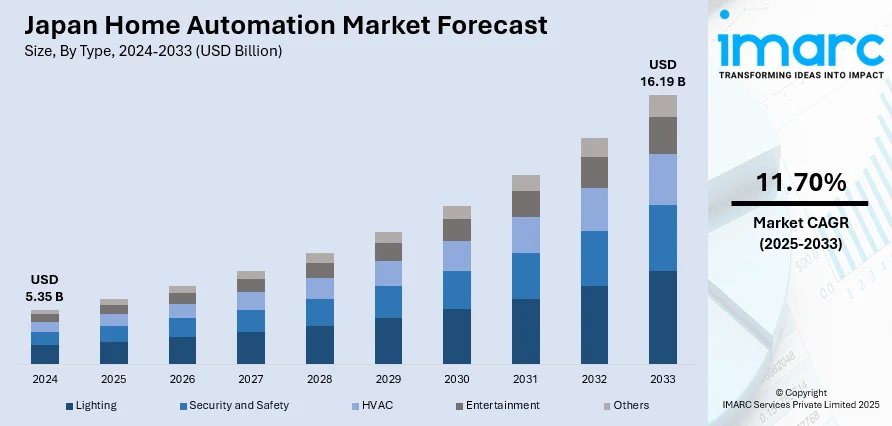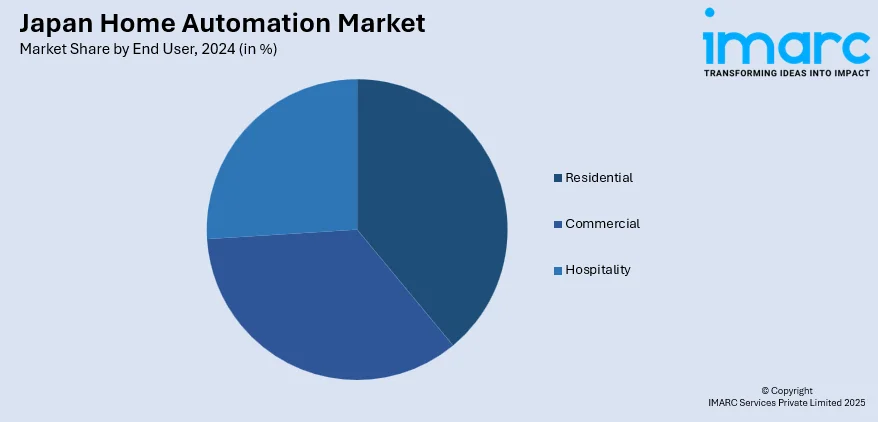
Japan Home Automation Market Size, Share, Trends and Forecast by Type, Technology, End User, and Region, 2025-2033
Japan Home Automation Market Overview:
The Japan home automation market size reached USD 5.35 Billion in 2024. Looking forward, IMARC Group expects the market to reach USD 16.19 Billion by 2033, exhibiting a growth rate (CAGR) of 11.70% during 2025-2033. The market is driven by the aging population’s need for assistive living and safety technologies. Also, smart systems that enhance space efficiency in dense urban homes are fueling the product adoption. Additionally, government-backed digital policies and energy initiatives support long-term adoption. Demographic shifts, compact living preferences, and infrastructure modernization are some of the other factors positively impacting the Japan home automation market share.
|
Report Attribute
|
Key Statistics
|
|---|---|
|
Base Year
|
2024 |
|
Forecast Years
|
2025-2033
|
|
Historical Years
|
2019-2024
|
| Market Size in 2024 | USD 5.35 Billion |
| Market Forecast in 2033 | USD 16.19 Billion |
| Market Growth Rate 2025-2033 | 11.70% |
Japan Home Automation Market Trends:
Aging Population and Demand for Assistive Living Technologies
Japan’s elderly population has reached a record 36.25 million, accounting for 29.1% of the total population, according to government data. This demographic shift is intensifying demand for home automation technologies that support aging in place, including AI-driven monitoring, voice-activated systems, and adaptive environments. Home automation systems are increasingly viewed as essential tools to support independent living for elderly residents. Features such as automated lighting, remote-controlled appliances, voice-activated systems, and smart monitoring solutions are being adopted to enhance safety, convenience, and day-to-day functionality. Family members and caregivers often use remote access to monitor activity patterns, receive alerts, and check on the wellbeing of elderly relatives without being physically present. Japanese electronics manufacturers and housing developers are responding by integrating automation capabilities into home layouts, particularly in urban condominiums and assisted-living complexes. Demand is especially strong in prefectures with aging populations such as Akita, Kochi, and Shimane. This shift is a significant factor driving Japan home automation market growth, with aging-in-place technologies becoming a central element of residential design. As healthcare infrastructure integrates more with in-home tech, home automation will remain closely tied to national aging policy objectives and consumer expectations around dignity and independence in later life.

High Urban Density and Space Optimization Through Smart Living
Japan’s urban centers, particularly Tokyo, Osaka, and Yokohama, are characterized by limited residential space, prompting demand for systems that improve spatial efficiency. Home automation plays a central role in this trend by enabling multifunctional living environments through centralized control systems. Residents increasingly use smart lighting, automated blinds, voice-controlled entertainment systems, and climate management to optimize comfort in compact apartments. The popularity of integrated, app-based platforms has made it easier for users to manage multiple functions from a single interface, reducing clutter and physical switches. On January 28, 2025, NTT DATA launched its Smart AI Agent™, an autonomous AI tool designed to accelerate generative AI adoption across industries, with applications likely to influence the smart home and building automation space. The agent enables multi-device collaboration, automates task planning, and performs contextual data analysis without relying on central systems, aligning with Japan’s privacy-conscious and decentralized tech trends. Modular furniture and built-in automation are becoming more prevalent in new housing projects, particularly those targeting younger professionals and dual-income households. Developers are partnering with tech firms to deliver ready-to-move-in smart units that appeal to convenience-focused urban buyers. Voice assistant adoption, particularly devices designed for Japanese-language interaction, has further strengthened this trend, making automation more intuitive for all age groups. In dense residential areas where lifestyle efficiency and convenience are highly valued, automation serves both functional and aspirational purposes, aligning with broader cultural preferences for minimalism, efficiency, and precision.
Japan Home Automation Market Segmentation:
IMARC Group provides an analysis of the key trends in each segment of the market, along with forecasts at the country and regional levels for 2025-2033. Our report has categorized the market based on type, technology, and end user.
Type Insights:
- Lighting
- Relay
- Dimmers
- Switches
- Others
- Security and Safety
- Bells
- Locks
- Security Cameras
- Others
- HVAC
- Thermostats
- Sensors
- Control Valves
- Others
- Entertainment
- Home Theater System
- Audio, Volume, and Multimedia Controls
- Others
- Others
The report has provided a detailed breakup and analysis of the market based on the type. This includes lighting (relay, dimmers, switches, and others), security and safety (bells, locks, security cameras, and others), HVAC (thermostats, sensors, control valves, and others), entertainment (home theater system, audio, volume, and multimedia controls, and others), and others.
Technology Insights:
- Wired
- Wireless
The report has provided a detailed breakup and analysis of the market based on the technology. This includes wired and wireless.
End User Insights:

- Residential
- Commercial
- Hospitality
The report has provided a detailed breakup and analysis of the market based on the end user. This includes residential, commercial, and hospitality.
Regional Insights:
- Kanto Region
- Kansai/Kinki Region
- Central/Chubu Region
- Kyushu-Okinawa Region
- Tohoku Region
- Chugoku Region
- Hokkaido Region
- Shikoku Region
The report has also provided a comprehensive analysis of all major regional markets. This includes Kanto Region, Kansai/Kinki Region, Central/Chubu Region, Kyushu-Okinawa Region, Tohoku Region, Chugoku Region, Hokkaido Region, and Shikoku Region.
Competitive Landscape:
The market research report has also provided a comprehensive analysis of the competitive landscape. Competitive analysis such as market structure, key player positioning, top winning strategies, competitive dashboard, and company evaluation quadrant has been covered in the report. Also, detailed profiles of all major companies have been provided.
Japan Home Automation Market News:
- May 5, 2025: Researchers at the University of Tokyo have introduced a decentralized AI system for building automation that enhances privacy by eliminating central data storage. Named D-LFBA (Distributed Logic-Free Building Automation), the system enables direct device-to-device communication among sensors, cameras, and controllers, allowing it to learn user behavior locally without programmed logic.
Japan Home Automation Market Report Coverage:
| Report Features | Details |
|---|---|
| Base Year of the Analysis | 2024 |
| Historical Period | 2019-2024 |
| Forecast Period | 2025-2033 |
| Units | Billion USD |
| Scope of the Report |
Exploration of Historical Trends and Market Outlook, Industry Catalysts and Challenges, Segment-Wise Historical and Future Market Assessment:
|
| Types Covered |
|
| Technologies Covered | Wired, Wireless |
| End Users Covered | Residential, Commercial, Hospitality |
| Regions Covered | Kanto Region, Kansai/Kinki Region, Central/Chubu Region, Kyushu-Okinawa Region, Tohoku Region, Chugoku Region, Hokkaido Region, Shikoku Region |
| Customization Scope | 10% Free Customization |
| Post-Sale Analyst Support | 10-12 Weeks |
| Delivery Format | PDF and Excel through Email (We can also provide the editable version of the report in PPT/Word format on special request) |
Key Questions Answered in This Report:
- How has the Japan home automation market performed so far and how will it perform in the coming years?
- What is the breakup of the Japan home automation market on the basis of type?
- What is the breakup of the Japan home automation market on the basis of technology?
- What is the breakup of the Japan home automation market on the basis of end user?
- What is the breakup of the Japan home automation market on the basis of region?
- What are the various stages in the value chain of the Japan home automation market?
- What are the key driving factors and challenges in the Japan home automation market?
- What is the structure of the Japan home automation market and who are the key players?
- What is the degree of competition in the Japan home automation market?
Key Benefits for Stakeholders:
- IMARC’s industry report offers a comprehensive quantitative analysis of various market segments, historical and current market trends, market forecasts, and dynamics of the Japan home automation market from 2019-2033.
- The research report provides the latest information on the market drivers, challenges, and opportunities in the Japan home automation market.
- Porter's five forces analysis assist stakeholders in assessing the impact of new entrants, competitive rivalry, supplier power, buyer power, and the threat of substitution. It helps stakeholders to analyze the level of competition within the Japan home automation industry and its attractiveness.
- Competitive landscape allows stakeholders to understand their competitive environment and provides an insight into the current positions of key players in the market.
Need more help?
- Speak to our experienced analysts for insights on the current market scenarios.
- Include additional segments and countries to customize the report as per your requirement.
- Gain an unparalleled competitive advantage in your domain by understanding how to utilize the report and positively impacting your operations and revenue.
- For further assistance, please connect with our analysts.
 Request Customization
Request Customization
 Speak to an Analyst
Speak to an Analyst
 Request Brochure
Request Brochure
 Inquire Before Buying
Inquire Before Buying




.webp)




.webp)












